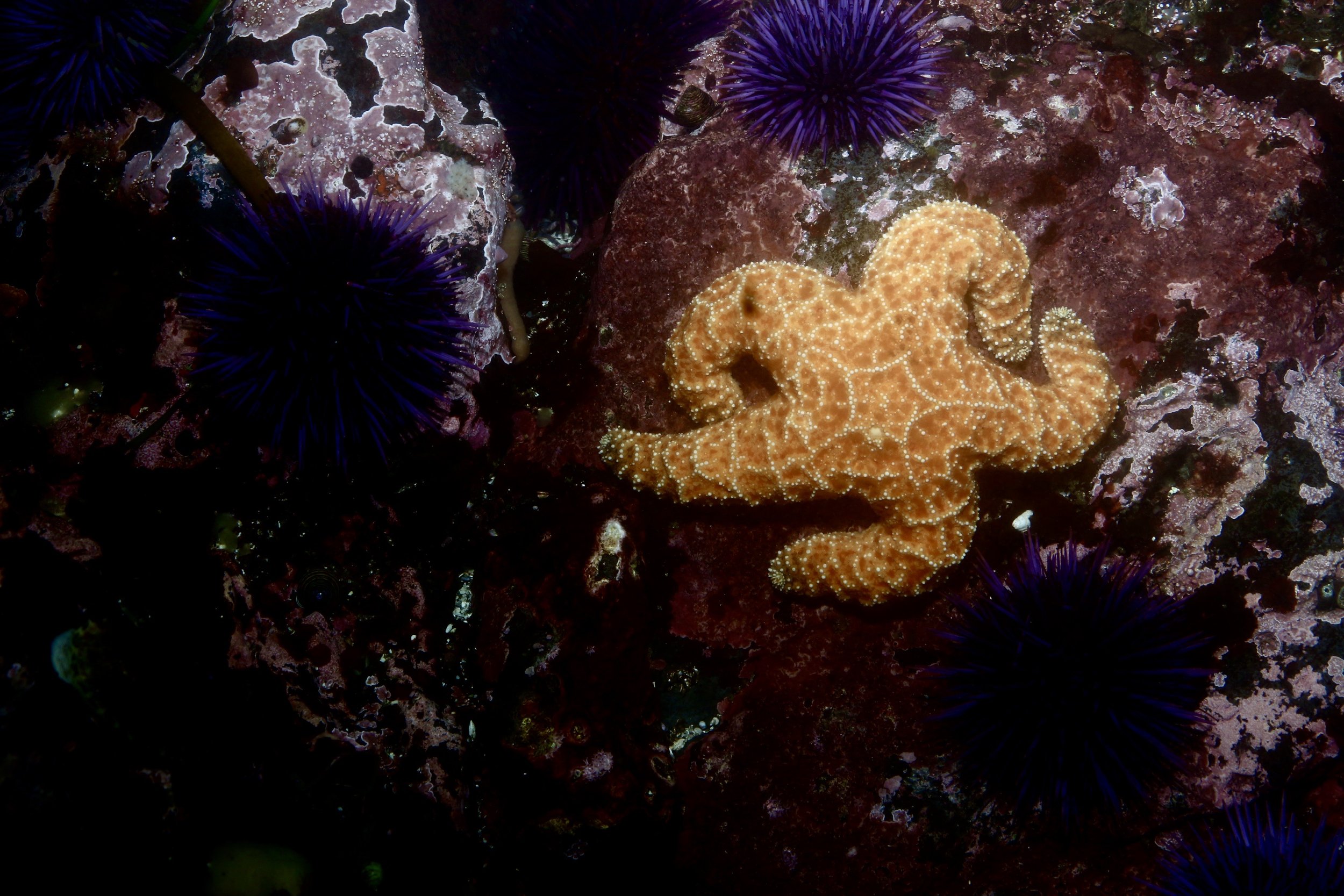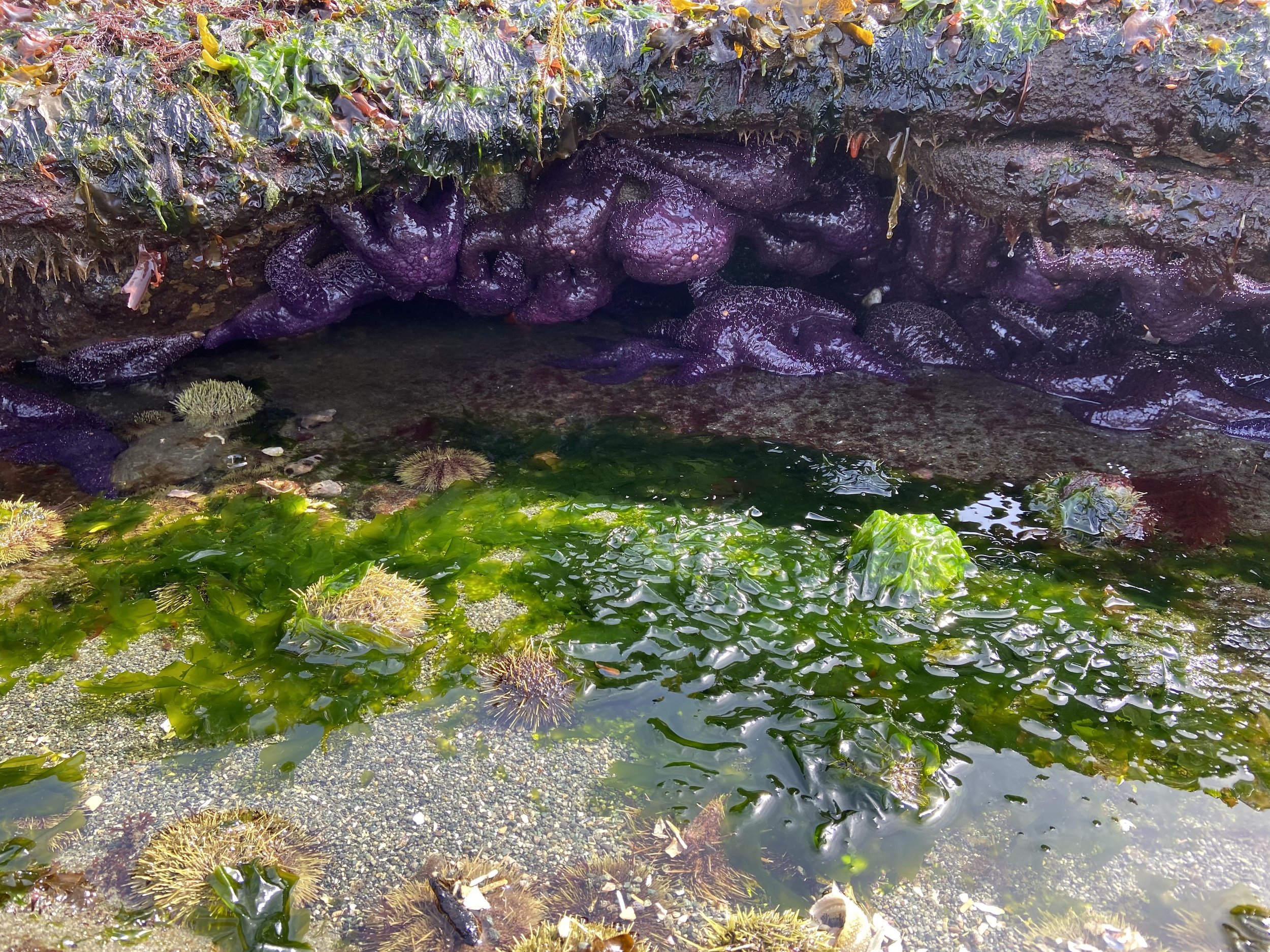Ochre Star
Pisaster ochraceus
Few species have reached such fame as the stalwart Ochre star. This species is universally loved by just about every resident and visitor of the coastal Pacific Northwest. Lucky for the Ochre star, we love them for their appearance and not for their taste.
Looks can be deceiving however, as the Ochre star (much like many local sea stars), are voracious predators. While they may have the texture and personality of a rock, and at first do not seem to move at all, this species can hunt down and consume its prey with terrifying efficiency (just at their own pace) [1].
My artwork of the orange and purple Ochre stars were each inspired by the two photographs below:
August 2019: A large, orange Ochre star rests among a group of Purple sea urchins of of Big Beach in Ucluelet, B.C.
April 2016: A purple Ochre star climbs up a piling in search of Giant acorn barnacles underneath the Discovery Pier in Campbell River, B.C.
📖 Description 📖
Sea stars belong to a group of animals known as echinoderms. This latin word means ‘spiny skin’ in english, and refers to the prickly of the group’s members; sea cucumbers, sea urchins, crinoids, and brittle stars all belong to this group.
Most often, Ochre stars have five arms, but can have as many as six, or as few as one! When an Ochre star has fewer than 5 arms, it is likely due to an injury from a predator. Sea stars are capable of regenerating limbs, which can take up to one year or possibly longer in some species [2].
While many believe the sea star wasting epidemic has come to pass, Ochre star populations across most of their distribution have yet to fully recover. Future threats such as the increasing intensity of winter storms and summer heat waves still challenge the healthy future of all Pacific Northwest sea stars [1].
June 2019: A healthy ‘constellation’ of Ochre stars huddled against a large boulder for protection in Campbell River, B.C.
🌎 Distribution 🌎
The Ochre star is found clinging to shorelines ranging from the Gulf of Alaska down through to Central California. Further south along the coast, a subspecies of the Ochre star can be found known as Pisaster ochraceus segnis. This subspecies is found as far south as Baja California [3].
Distribution of the Ochre star, Pisaster ochraceus. Range of Pisaster ochraceus segnis omitted. Suitable habitat depicted in red.
🏝 Habitat 🏝
Most folks who have visited the Pacific coast are quite familiar with the intertidal habitat of the Ochre star, but what you might not know is that they are not just found in the intertidal zone. Ochre stars have been spotted up to 90 meters below the surface!
Most often however, Ochre stars are seen in less than 10 meters of water as that is where their sources of food are most abundant. This particular species of sea star has incredibly strong tube feet which it uses to anchor to rocks in the intertidal zone. This helps the sea star stay put during intense storms and when under attack by predators.
Depth of suitable habitat for the Ochre star, Pisaster ochraceus. Suitable habitat depicted in red. Not to scale.
Ochre stars are most comfortable in rocky habitats, whether they be in the intertidal or subtidal zones. On occasion, you may see an Ochre star crawling across sand or gravel where they are often on the move, searching for some rocks to cling onto for safety. After all, it can be difficult to get a grip on the sea floor when all there is to grab is sand or pebbles!
Among rocky habitats there can be a lot of variation, whether it be a sheer cliff face, rocky beach, or something in between. If a habitat has rocks and is close to shore, there is a good chance there are at least a few Ochre stars around so keep your eyes open!
February 2020: A very large, orange Ochre star crawls amongst a grove of Articulated corraline algae in Monterey, California.
🦪 Diet 🦪
If a local sea animal has a shell, doesn’t move very fast, and likes to eat plankton, there is a very good chance that it is Ochre star prey. Barnacles, mussels, clams, and oysters are all among the Ochre star’s favourite foods. This species will also hunt down sea snails and limpets when the opportunity presents itself.
As many are aware, the Ochre star has a very strange way of eating. When an Ochre star has captured a mussel for instance, it uses its very strong tube feet to pull apart the shell valves of the mussel and pushes its stomach out from its mouth, into the mussel’s shell. The stomach then secretes digestive juices inside the mussel and digests it from the inside out [1].
On many beaches, the ochre star is considered a keystone species, as they eat so many mussels that they have a dramatic effect on the habitats they live in. By eating mussels, the sea stars clear space for other species to thrive, such as limpets, sea anemones, and seaweeds.
⭐ Life Cycle ⭐
A large number of local marine species can actually live very long lives. The Ochre star is no exception. Ochre stars have been documented living for up to 20 years, and in some cases, the same ochre stars can be visited in the same region year after year [1].
Ochre stars can be male or female, however it is nearly impossible to tell the difference between the two. During Ochre star spawning season (which occurs unpredictably in the spring), male and female Ochre stars will all begin releasing their eggs and sperm into the surrounding sea water. It is in the sea water that the eggs are fertilized. This method of reproduction is known as broadcast spawning.
These fertilized eggs develop into a larva known as a bipinnariae, which lives as a plankton in the sea water. After proceeding through the brachiolaria stage, the sea star larvae is ready to begin the next step of its life, it settles to the sea floor, and metamorphoses into a juvenile sea star [4].
May 2021: Ochre stars huddled underneath a rocky crevasse in Campbell River, B.C.
📚 References 📚
[1] Fretwell, K., Brietzke, C., & Starzomski, B. (2013). Ochre star. Central Coast Biodiversity. https://www.centralcoastbiodiversity.org/ochre-star-bull-pisaster-ochraceus.htmlsdf
[2] Edmondson, C., (1935). Autotomy and regeneration of Hawaiian starfishes. Bishop Museum Occasional Papers, 11(8). http://hbs.bishopmuseum.org/pubs-online/pdf/op11-8.pdf
[3] Humphreys, V. (2003, December 16). The Biogeography of the Purple Ochre Sea Star (Pisaster ochraceus). San Francisco State University. https://web.archive.org/web/20090529035845/http://bss.sfsu.edu/holzman/courses/Fall%2003%20project/oseastar.htm
[4] Hiebert, T.C. & Hiebert, L.(2015). Pisaster ochraceus. In: Oregon Estuarine Invertebrates: Rudys' Illustrated Guide to Common Species. (3rd ed.). https://scholarsbank.uoregon.edu/xmlui/bitstream/handle/1794/12925/P_ochraceus_2015_final.pdf?sequence=3







